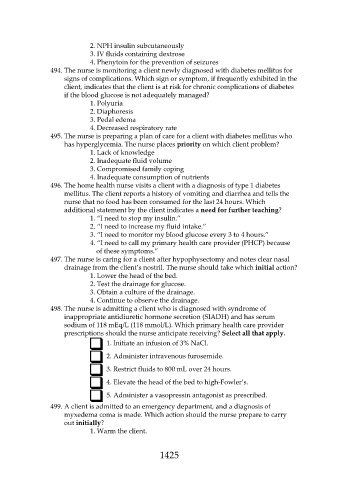Page 1425 - Saunders Comprehensive Review For NCLEX-RN
P. 1425
2. NPH insulin subcutaneously
3. IV fluids containing dextrose
4. Phenytoin for the prevention of seizures
494. The nurse is monitoring a client newly diagnosed with diabetes mellitus for
signs of complications. Which sign or symptom, if frequently exhibited in the
client, indicates that the client is at risk for chronic complications of diabetes
if the blood glucose is not adequately managed?
1. Polyuria
2. Diaphoresis
3. Pedal edema
4. Decreased respiratory rate
495. The nurse is preparing a plan of care for a client with diabetes mellitus who
has hyperglycemia. The nurse places priority on which client problem?
1. Lack of knowledge
2. Inadequate fluid volume
3. Compromised family coping
4. Inadequate consumption of nutrients
496. The home health nurse visits a client with a diagnosis of type 1 diabetes
mellitus. The client reports a history of vomiting and diarrhea and tells the
nurse that no food has been consumed for the last 24 hours. Which
additional statement by the client indicates a need for further teaching?
1. “I need to stop my insulin.”
2. “I need to increase my fluid intake.”
3. “I need to monitor my blood glucose every 3 to 4 hours.”
4. “I need to call my primary health care provider (PHCP) because
of these symptoms.”
497. The nurse is caring for a client after hypophysectomy and notes clear nasal
drainage from the client’s nostril. The nurse should take which initial action?
1. Lower the head of the bed.
2. Test the drainage for glucose.
3. Obtain a culture of the drainage.
4. Continue to observe the drainage.
498. The nurse is admitting a client who is diagnosed with syndrome of
inappropriate antidiuretic hormone secretion (SIADH) and has serum
sodium of 118 mEq/L (118 mmol/L). Which primary health care provider
prescriptions should the nurse anticipate receiving? Select all that apply.
1. Initiate an infusion of 3% NaCl.
2. Administer intravenous furosemide.
3. Restrict fluids to 800 mL over 24 hours.
4. Elevate the head of the bed to high-Fowler’s.
5. Administer a vasopressin antagonist as prescribed.
499. A client is admitted to an emergency department, and a diagnosis of
myxedema coma is made. Which action should the nurse prepare to carry
out initially?
1. Warm the client.
1425

